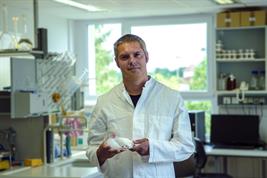05.10.2021

The past few years of drought have impressively demonstrated: Even in Central Europe, rainfall can be so scarce that the yield is at risk. Researchers at the Leibniz Centre for Agricultural Landscape Research (ZALF) are now looking for a solution in the agricultural soil: Fertilization with amorphous silicate, a silicon compound that is sometimes even produced as a waste product in industry, could solve several problems of modern agriculture in just a few years. Amorphous silicate increases the soil's ability to store water and has a positive effect on the availability of nutrients, thus enabling better plant growth. The research work at ZALF is funded by the German Research Foundation (DFG).
Project leader Dr. Jörg Schaller and his team first introduced "amorphous silicate" into the soil of a number of experimental fields at the Leibniz Centre for Agricultural Landscape Research (ZALF) in Müncheberg in 2020. The scientists hope for several benefits: A large proportion of the important plant nutrient phosphorus, which is applied through fertilization, binds tightly to soil particles and is therefore inaccessible for plants. Silicic acid being released from amorphous silicate mobilizes phosphorus from its strong binding to soil particles, making the phosphorus readily available to plants. Fertilization with phosphorus could thus be significantly reduced in the long term, which is an important step toward saving resources in agriculture in view of dwindling phosphorus reserves worldwide.
The scientists observed another important effect of the amorphous silicate in their experiments: their ability to store water. Amorphous silicate attracts water molecules like a sponge. "If the top 20 centimeters of the soils have one percent more of this substance, we found 40 percent more plant available water," says Jörg Schaller, describing the results of the first experiments. In a drought, this extra water could be life-saving for the plant until the next rainfall and could reduce yield losses. Excessive silicate fertilization, on the other hand, could release more nutrients than the plants can absorb and lead to leaching into water systems, where there would then be a risk of massive increases in algae bloom. Further research on possible environmental effects of this kind will be one of the tasks of the coming years.
Agriculture interrupts the natural silicate cycle
Amorphous silicate is a collective term for many different compounds, but their core is always silicon. The micrometer-sized complexes of silicon, oxygen and water molecules have received little attention in research to date, but they are enormously important for the nutrient and water balance of soils, as recent studies showed.
"Natural, undisturbed soils contain up to six or seven percent amorphous silicate", Schaller explains. Plants accumulate the silicon compounds in their stems and leaves, where they provide stability and ward off predators. In natural systems, the compounds are recycled back into the soil as soon as the plant dies and is being decomposed. On agricultural land, this cycle is interrupted. With the harvest, some of it disappears from the cycle each year until the amorphous silicate content has fallen to often less than one percent.
Soil properties matter
"There are now many studies that show that plants grow better when there is more amorphous silicate in the soil", he explains. Up to now, however, this had been attributed to the fact that processes such as photosynthesis or the absorption of nutrients in plants change. "Now we have been able to show that it is actually the soil properties that matter", Schaller says.
ZALF is already receiving inquiries from the agricultural sector, which is urgently seeking solutions to the increasing problems with drought. Schaller's team has had to temper expectations somewhat, however: "We have a long way to go before the method can be put into practice. But in five years, I expect to see the first applications."
His team has already received recognition for its research: Jörg Schaller was shortlisted for the “Falling Walls Science Breakthroughs of the Year 2021” in the Life Sciences category for his approach to increasing soil water availability, and thus for potentially contributing to stabilizing global food production in times of climate change. In commemoration of the fall of the Berlin Wall in 1989, "Falling Walls" is hosting a science summit from November 7 to 9 to gather and honor scientists who are researching solutions to the great challenges of our time.
 Press Release as PDF file
Press Release as PDF file
Further information:
Pictures
For downloading the pictures please click on a picture and use the icon.

